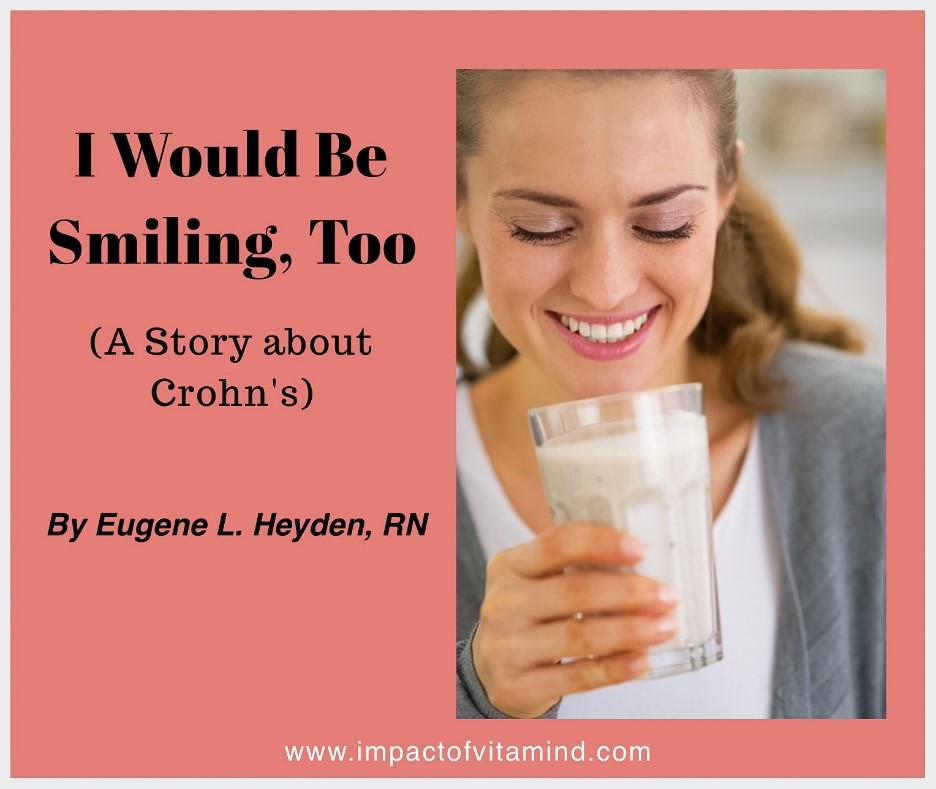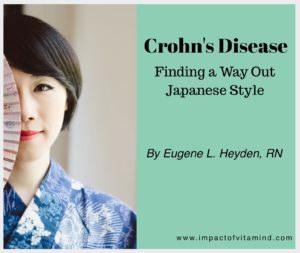I Would Be Smiling, Too

Last update: 01-14-24
By Eugene L. Heyden, RN
Could it be that this lady is smiling because she has found one of the most powerful treatments available anywhere for the treatment of Crohn’s. She is in remission now. She wants to keep smiling.
“Nutritional therapy for active Crohn’s disease (CD) is an underutilized form of treatment in adult patients, though its use is common in the paediatric population. There is evidence that nutritional therapy can effectively induce remission of CD in adult patients. Enteral nutrition is safe and generally well tolerated.” (Smith, 2008)
It would be very difficult to find a treatment for Crohn’s diseases more effective and easier to endure than the diet I am about to share with you. Admittedly, taking a drug is a lot easier than following a diet, but do you always want to take the easy path? (Apparently not. You have Crohn’s.) What should be foremost in mind is safety and effectiveness. Steroids can be effective, yet dangerous. Biologics can be effective, yet dangerous. Thank goodness there is an alternative to danger. It is called enteral feeding. And it has a great track record.
“In the acute phase, total enteral feeding with either elemental or polymeric diets is expected to induce remission in 70% of cases. Several trials have established that enteral nutrition is as effective as steroids.” (Verma et al., 2000, emphasis added)
“These well characterized outcomes [associated with exclusive enteral nutrition], specifically early mucosal healing, compare favorably with all currently available induction therapies, including anti-TNF agents and particularly superior to steroids. Steroids have poor ability to induce mucosal healing with active endoscopic disease in 71 % despite clinical remission, with only 12 % achieving complete mucosal healing.” (Grovere al., 2014)
So, let’s see what this enteral feeding business is all about. Unless you’ve read my book, have conducted a little literature research on your own, or have a physician who favors this approach, I doubt you know any of this. But it would be safe to say that you, the Crohn’s patient, probably qualify for this form of therapy.
“Nutritional support using liquid formulas should be considered for CD patients and in serious cases of ulcerative colitis (UC), especially for those who may require prolonged cycles of corticosteroids. Given that the ultimate goal in the treatment of CD is mucosal healing, this advantage of EN [enteral nutrition] over corticosteroid treatment is valuable in therapeutic decision-making. EN is indicated in active CD, in cases of steroid intolerance, in patients’ refusal of steroids, in combination with steroids in undernourished individuals, and in patients with an inflammatory stenosis of the small intestine.” (Triantafillidis et al., 2015)
Enteral feeding is a liquid diet that supplies all the nutrition an individual needs, without all the lumps and the bumps. (Chewing can be so boring.) Liquid nutrition has certain advantages over the lumps and bumps you are used to dealing with. Per Goulet, 2010, the advantages include: 1) bowel rest, 2) reduced intestinal secretions, 3) low antigenic load, 4) decreased intestinal permeability, 5) anti-inflammatory effect of diet (per transforming growth factor-beta (TGF-β2), 6) modulation of intestinal microbiota (bacterial flora), 7) topical nutrients, and 8) improved nutritional status. All of the above act to modify the inflammatory response and promote healing. I’ll bet you could use some healing now.
I think I just mentioned TGF-β2. Let’s take a look at an enteral feed that is engineered to generously provide this healing factor. It is called Modulen IBD. It is manufactured by the kind folks at Nestle. (I love them, but for different reasons.)
Modulen IBD
“Dietetic intervention with polymeric diet rich in TGF-β2 represents a quite satisfactory therapeutic modality in adult patients with mild to moderate active Crohn’s disease.” (Triantafillidis et al., 2006)
“In this study we have shown that by substituting two meals with a polymeric, rich in TGF-β, diet (Modulen IBD) for six months, we can achieve better results (although not statistically significant) compared to mesalamine administration (800 mg three times a day) in maintaining remission in patients with quiescent CD.” (Triantafillidis et al., 2010)
Modulen IBD is a complete meal, with every nutritional requirement met. Just add water and here you go! A meal in an instant. Then, you drink your way into remission. In so many cases, this is all it takes, and remission can occur in as little as two weeks. Two weeks! But it could occur in four weeks, six weeks or eight. Four weeks! Six weeks! Eight weeks! And tell me again, “Why is this form of therapy not in front-line use in the battle against Crohn’s?”
“Enteral diets—both elemental and polymeric—used as a primary therapy in Crohn’s disease have been shown to induce disease remission without concomitant use of other medications. Furthermore, supplementary enteral nutrition after primary therapy and after remission is induced may be associated with the prolongation of remission and linear growth. The pathways by which enteral diets may affect mucosa inflammation are manifold. Practically, there is evidence that an enteral diet has a direct effect on the gut mucosa by reducing cytokine production and the accompanying inflammation.” (Hartman et al., 2008)
Now with respect to Modulen IBD, this product seems to be a wise choice. As mentioned, Modulen IBD contains TGF-β2. It was designed to not only include this anti-inflammatory factor in generous amounts, it was also designed to protect it from digestion in the stomach so that it could survive and effect healing below. And with TGF-β2, you’re playing with power.
“TGF-β is a key regulator in immune system homeostasis, and dysfunction of TGF-β may result in disorders of this system, such as autoimmunity and inflammatory bowel disease.” (Yan et. Al., 2009)
“TGF-β is necessary for normal immune regulation. Indeed, TGFβ was first described as the most potent endogenous [produced within the organism] immunosuppressive factor (similar to cyclosporine) in the immune system.” (Oz et al., 2004, emphasis added)
Modulen IBD can be used as a sole source of nutrition for any length of time, or it can be added to a diet plan that includes the usual lumps and bumps we have learned to enjoy. I suppose, if you want to use Modulen IBD exclusively for the first phase of your treatment, say for the first two to four weeks or so, this would be a good call. This course of action may maximize the benefits of enteral feeding. But you may just start missing all the chewing. There is good news for you. In one strategy, go ahead and eat real people food once a day, and drink a Modulen IBD meal replacement twice daily.
Unlike the complicated diets for Crohn’s, this diet so easy! You simply follow a Modulen IBD protocol—either the one that involves using Modulen IBD exclusively or the one that allows Modulen IBD plus real people food. And more likely than not, you will achieve remission and perhaps maintain remission for quite some time. Forever is in the relm of possibilities, too. And sometimes, even fistulas can improve and resolve. (see Triantafillidis et al., 2006)
Now, of course, not everyone will go into remission with Modulen IBD or, for that matter, with any other enteral feed. Some have followed other protocols for extended periods of time without success (e.g., various drug protocols or alternative therapies) and are basically a train wreck (unfolding, slowly, over time), so they may be too fragile or too damaged to benefit from this form of therapy. Of course, relapse with enteral feeding is always a strong possibility. And this does happen, and happen way too often. I have a suggestion. Read my post Crohn’s Disease: Finding a Way Out Japanese Style. Following the diet outlined in this article, may just be the ticket when it comes to maintaining the remission induced by enteral feeding.
Now for the bad news. Modulen IBD is currently unavailable in the good ol’ USA. (I’ll work on them.) However, you can purchase it in Canada, Russia, Brazil, the United Kingdom, and several other foreign countries. It used to be available in the USA, but the demand was too low to keep it on the shelf. But there are options.
One option is to take your next vacation in Canada and stock up, then return home and consume. Another option is to find a friend in Canada who will purchase Modulen IBD for you and ship it to you. But I have another plan. You can make a fake Modulen IBD by using, under physician supervision, a suitable commercial liquid-meal replacement and take a colostrum supplement with each enteral feeding. Colostrum is loaded with TGF-β2. Make sure the meal replacement formula includes casein as a protein source, since casein protects TGF-β2 from digestive degradation (Triantafillidis et al., 2006). Another option is to use enteric coated colostrum, which should allow the colostrum to release below the digestive environment of the stomach, irrespective whether a casein-based formulation is chosen. Sorry, I’m not sure how much colostrum it would take to approximate the amount of TGF-β2 in Modulen IDB. Here’s a hint: The TGF-β2 content of Modulen IBD is > 24 p.p.m. (Triantafillidis et al., 2010) Ask your physician, who needs to approve this form of therapy anyway, how many colostrum capsules might be required to approximate the amount of TGF-β2 found in a given amount of Modulen IBD. My guess is it would take several.
Another option is to completely forget about Modulen IBD and TGF-β2, and choose another enteral formula currently on the market. There are several that have a good track record. Do a little searching and find one on your own. (Don’t make me do all the work for you.) Seek your physician’s approval! Do some convincing. Make it happen! Make it your mission in life to make enteral feeding successful. Have a winning attitude. A highly motivated patient is more apt to become successful with this form of therapy than an individual who is just does things because he or she has to do things. And remember, if others can achieve and maintain remission with enteral feeding, why can’t you?
“These well characterized outcomes [associated with enteral feeding], specifically early mucosal healing, compare favorably with all currently available induction therapies, including anti-TNF agents and particularly superior to steroids. Steroids have poor ability to induce mucosal healing with active endoscopic disease in 71 % despite clinical remission, with only 12 % achieving complete mucosal healing.” (Grover et al., 2014)
“It is my impression that nutritional therapy is used for remission in only a minority of centers, at least in the United States. Why do clinicians treating children with inflammatory bowel disease not use nutritional therapy more aggressively, given the preponderance of evidence of its effectiveness, combined with a relative lack of side effects?” (Borrelli et al., 2006)
Note: Recently, a product called Modulin (without IBD in the name, but which likely contains plenty of TGF-β2, has become available without a prescription in the USA. It is part of an exciting new program called the Crohn’s Disease Exclusion Diet, or CDED. I’ll be writing a post on this soon. Stay tuned!
Related posts (Click image to open)
Suggested reading
Adult Enteral Formulas Adult Enteral Formulas – [PDF Document] (fdocuments.net)
D’Argenio V, Precone V, Casaburi G, Martinelli M, Staiano A, Salvatore F, Sacchetti J 2013 An Altered Gut Microbiome Profile in a Child Affected by Crohn’s Disease Normalized After Nutritional Therapy. The American Journal of Gastroenterology; May; 108(5):851–852 An Altered Gut Microbiome Profile in a Child Affected by Crohn’s Disease Normalized After Nutritional Therapy – PMC (nih.gov)
Kansal S, Wagner J, Kirkwood CD, Catto-Smith AG 2013 Enteral Nutrition in Crohn’s Disease: An Underused Therapy. Gastroenterology Research and Practice. Dec 5; 2013. Enteral Nutrition in Crohn’s Disease: An Underused Therapy (hindawi.com)
Oppenheimer MA 2009 Beat Crohn’s! Getting to Remission with Enteral Nutrition. Solutions, Long Island City, New York ISBN-13: 978-0-9821234-4-7
References
Borrelli O, Cordischi L, Cirulli M, Paganelli M, Labalestra V, Uccini S, Russo PM 2007 Polymeric Diet Alone versus Corticosteroids in the Treatment of Active Crohn’s Disease: A Randomized Controlled Open-Label Trial. Clin Gastroenterol Hepatol; June; 4(6):744–753
Grover Z, Muir R, Lewindon P 2014 Exclusive Enteral Nutrition Induces Early Clinical, Mucosal and Transmural Remission in Paediatric Crohn’s Disease. Journal of Gastroenterology. Apr 1; 49(4):638–645
Hartman C, Berkowitz D, Weiss B, Shaoul R, Levine A, Adiv OE, Shapira R, et al 2008 Nutritional Supplementation with Polymeric Diet Enriched with Transforming Growth Factor-Beta 2 for Children with Crohn’s Disease. IMAJ 10:503–507
Oz HS, Ray M, Chen TS, McCIain CJ 2004 Efficacy of a Transforming Growth Factor β2 Containing Nutritional Support Formula in a Murine Model of Inflammatory Bowel Disease. Journal of the American College of Nutrition 23(3):220–226
Smith PA 2008 Nutritional Therapy for Active Crohn’s Disease. World J Gastroenterol; July 21; 14(27):4420–4423
Triantafillidis JK, Stamataki A, Gikas A, Sklavaina M, Mylonaki M, Georgopoulos F, Mastragelis A, Cheracakis P 2006 Beneficial Effect of Polymeric Feed. Rich in TGF-β, on Adult Patients with Active Crohn’s Disease: A Pilot Study. Annals of Gastroenterology 19(1):66–71
Triantafillidis JK, Stamataki A, Karagianni V, Gikas A, Malgarinos G 2010 Maintenance Treatment of Crohn’s Disease with a Polymeric Feed Rich in TGFβ. Annals of Gastroenterology 23(2):113–118
Triantafillidis JK, Vagianos C, Papalois AE 2015 The Role of Enteral Nutrition in Patients with Inflammatory Bowel Disease: Current Aspects. BioMed Research International. Feb 22; 201
Verma S, Kirkwood B, Brown S, Giaffer MH 2000 Oral Supplementation Is Effective in the Maintenance of Remission in Crohn’s Disease. Digest Liver Dis 32:769–774
Yan X, Liu Z, Chen Y 2009 Regulation of TGF-β Signaling by Smad7. Acta Biophys Sin 41(4):263–272
Disclaimer: This article is presented solely for informational purposes. The information contained herein should be evaluated for accuracy and validity in the context of opposing data, new information, and the views and recommendations of a qualified health care professional, and is not to be substituted for professional judgment and guidance or to provide reason to neglect or delay appropriate medical care. It is the reader and reader only who bears the responsibility for any actions that could be construed as being a response to the information contained herein. The statements and opinions expressed by the author have not been reviewed or approved by the FDA or by any other authoritative body, nor is the author endorsing any product or specific therapy. This article is offered to the reader to broaden his or her understanding of the issues discussed and to help identify options that may be suitable for the individual to pursue, on behalf of self or others, under approval and direction of a qualified physician. The author and publisher offer no guarantees of the accuracy or validity of the quotations incorporated into this article or the accuracy or validity of the information presented by the references used in this article.
Copyright © 2016–2022 Eugene L. Heyden, RN
All Rights Reserved



